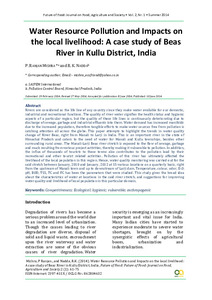| dc.date.accessioned | 2014-06-26T12:13:14Z | |
| dc.date.available | 2014-06-26T12:13:14Z | |
| dc.date.issued | 2014-06-10 | |
| dc.identifier.issn | 2197-411X | |
| dc.identifier.uri | urn:nbn:de:hebis:34-2014062645581 | |
| dc.identifier.uri | http://hdl.handle.net/123456789/2014062645581 | |
| dc.language.iso | eng | |
| dc.publisher | Department of Organic Food Quality and Food Culture at the University of Kassel, Germany and Federation of German Scientists (VDW) | eng |
| dc.rights | Urheberrechtlich geschützt | |
| dc.rights.uri | https://rightsstatements.org/page/InC/1.0/ | |
| dc.subject | Competitiveness | eng |
| dc.subject | Ecological | eng |
| dc.subject | hygienic | eng |
| dc.subject | vulnerable | eng |
| dc.subject | anthropogenic | eng |
| dc.subject.ddc | 630 | |
| dc.title | Water Resource Pollution and Impacts on the local livelihood: A case study of Beas River in Kullu District, India | eng |
| dc.type | Aufsatz | |
| dcterms.abstract | The rivers are considered as the life line of any country since they make water available for our domestic, industrial and recreational functions. The quality of river water signifies the health status and hygienic aspects of a particular region, but the quality of these life lines is continuously deteriorating due to discharge of sewage, garbage and industrial effluents into them. Thrust on water demand has increased manifolds due to the increased population, therefore tangible efforts to make the water sources free from pollution is catching attention all across the globe. This paper attempts to highlight the trends in water quality change of River Beas, right from Manali to Larji in India. This is an important river in the state of Himachal Pradesh and caters to the need of water for Manali and Kullu townships, besides other surrounding rural areas. The Manali-Larji Beas river stretch is exposed to the flow of sewage, garbage and muck resulting from various project activities, thereby making it vulnerable to pollution. In addition, the influx of thousands of tourists to these towns also contributes to the pollution load by their recreational and other tourist related activities. Pollution of this river has ultimately affected the livelihood of local population in this region. Hence, water quality monitoring was carried out for the said stretch between January, 2010 and January, 2012 at 15 various locations on quarterly basis, right from the upstream of Manali town and up to downstream of Larji dam. Temperature, color, odor, D.O. , pH, BOD, TSS, TC and FC has been the parameters that were studied. This study gives the broad idea about the characteristics of water at locations in the said river stretch, and suggestions for improving water quality and livelihood of local population in this particular domain. | eng |
| dcterms.accessRights | open access | |
| dcterms.bibliographicCitation | In: Future of Food: Journal on Food, Agriculture and Society. Witzenhausen : University of Kassel, Department of Organic Food Quality and Food Culture. - Vol. 2, No. 1 (2014), S. 61-75 | |
| dcterms.creator | Mishra, Priya Ranjan | |
| dcterms.creator | Nadda, R. K. | |

